- Home
- Jeff Mariotte
The Burning Season Page 6
The Burning Season Read online
Page 6
The loading area was pretty typical, if somewhat cleaner than those used for restaurants and supermarkets. Garbage dumpsters, pavement covered in oil and grease stains. A video surveillance camera was mounted above the dock, but its lens had been shattered. A rock on the ground beneath it might have been the culprit. Catherine crouched and found tiny glass shards on top of the rock, but when she fingered it aside, there were none beneath it, confirming her hunch. Other small stones were scattered here and there, so probably someone had stood back, out of the camera’s range, and thrown them until one connected.
If that was the case, then the person who had thrown the stones knew where to stand. She would check the video, see if she could catch a glimpse of him, but if her guess was right, she wouldn’t. She could also find out when the lens had been broken—if it was immediately before the fire started, or sometime earlier.
Initial indications pointed to someone on the inside, someone who had seen the video feed and knew the camera’s range. On the other hand, wouldn’t an insider have known that Daniels was still in the hospital, and not at work? She would know more after she did a more thorough investigation. After first making sure that the uniforms had secured the area, she hurried back to her car for her kit.
Whether the arsonist was a DCN insider or not, if it was the same person who had detonated the bomb, that person harbored a serious case of rage toward Dennis Daniels.
Rage like that wouldn’t go away on its own. It would keep seeking an outlet until it was satisfied. She would need to find the person before that happened, or Daniels would pay the final price.
Ray Langston went into the lab early. Since he had been stabbed, he hadn’t been sleeping well unless he was drugged. And he hated being drugged, because while the narcotics took the edge off the pain, they dulled his mind. When he did sleep, nightmares plagued him. So he avoided the painkillers and tried to work through the agony during his waking hours.
Catherine worried about him, which bothered him almost as much as the drugs did. Though he walked with a cane that Doc Robbins had given him, and he couldn’t always conceal the pain, or the weariness that overtook him much earlier than it once had, he tried to hide the symptoms from his co-workers, and especially from her. They tried to baby him, and he didn’t want any special treatment.
There were plenty of people working the bombing case, so he picked up where he had left off on the severed hand. He had left it in the morgue with Robbins. The medical examiner wasn’t in yet, but he had left a file folder on Ray’s desk.
Ray sat down—slowly and cautiously—and opened the file. There was a sticky note affixed to the inside, saying simply, “Ray, I had some spare time on my hands. AR.”
The file contained almost a dozen photographs. Robbins had made a cast of the bone at the end of the hand, the nubs of radius and ulna left behind when the hand was separated from the wrist. In the file, he had included photos of the actual hand, some made with a regular camera, and close-ups under a binocular microscope. With those, Ray could easily see what had attracted the medical examiner’s interest.
Visible on both the actual bone photos and the cast were tool marks, tiny but distinct striations on the edges of the bones.
The hand had been cut off.
What the dog had found was definitely evidence of a crime.
He set Doc Robbins’s file aside and found another one under it, this one from Carrie, a day shift DNA tech who had been helping with their caseload since Wendy’s departure. She hadn’t left a personal note, just a DNA report. Ray scrolled down the printout until he reached the most pertinent bit of data—a name and address.
He jotted those down on a separate piece of paper, then returned to the document for a more comprehensive study. Carrie had extracted DNA from bone marrow found in the hand, and used a short tandem repeat technique to analyze it. With short tandem repeats, one obtained fragments of DNA, which were then extended through polymerase chain reaction. Studying those with the single nucleotide polymorphism technique, she had isolated and printed out a graph, showing the STR peaks. Below that was another graph, this one depicting the STR peaks of a man named Carter Hawkins, who had submitted to a swabbing six years earlier, when a jewelry store he managed was robbed. The robbery was a smash-and-grab job, and the thief had cut himself on the glass, leaving behind traces of blood. Employees, Hawkins included, had volunteered their DNA to exclude them from suspicion. The thief had turned out to have nothing to do with the store. He’d been arrested while trying to sell the stolen jewelry to a pawnshop, and the DNA from the crime scene had helped convict him.
The Carter Hawkins DNA had remained in the system, though, and when Ray studied the peaks and valleys of the two graphs, they were identical. The chances that they didn’t come from the same person were somewhere in the neighborhood of a billion to one.
Ray put the printouts back into the folder, and checked to make sure that his and Doc Robbins’s were the only two that had been left on the desk during his attempt to get some sleep. They were.
Taking his cane in one hand and the sheet of paper with the name Carter Hawkins and an address in North Las Vegas in the other, Ray hobbled to his car.
The house was in a development that had been completed sometime in the last few years. The land-scaping—what there was, mostly desertscapes, cacti and succulents in fields of tiny tan rocks—was not yet mature, and the houses had not been lived in long enough to develop individual personalities. There were four styles of house, all of them two-story, with a few additional options available, and they were painted in the same three approved shades of brown and tan.
He found the address Carrie had left for him and parked in the drive. The only distinctive thing about this house was that someone had run a bumper into the garage door, and the damage had not yet been repaired.
When he rang the doorbell, he had to wait only a few seconds for a response. The door swung open, and a silver-haired man stood inside. He was Caucasian, fit and tanned, and he wore a polo shirt stretched tight across his muscular chest and shoulders. Tufts of gray hair coiled out of the open collar, and sun-kissed curls on his arms nearly hid his gold watch. Chunky gold rings graced three of his fingers. His face was lined, his cheeks carved with deep dimples extending all the way to his firm jawline. He had two hands, and they were both real, Ray noted.
“I’m sorry to bother you, sir. I’m Ray Langston, with the Las Vegas Crime Lab, and I’m looking for Carter Hawkins.”
“You found him.”
“Is there someone else with that name? A junior? Your father or your son?”
“I’m the one and only, far as I know. My pappy was a pistol, and I’m a son of a gun. But his name wasn’t Carter. If I have any sons, I don’t know about ’em. And at this age, I don’t want to find out.”
“I’m sorry, I’m a little confused.”
“You look downright lost, Mr. Langston.”
“Honestly, I was expecting to discover that Carter Hawkins was deceased. Or at least missing a hand.”
Hawkins clasped his together, flashing gold. “Got both of mine.” He pantomimed a golf swing.
“I can see that.”
“You mind telling me what this is about?”
“Before I do, can you prove that you’re Carter Hawkins?”
“You want my DNA?”
Ray chuckled. “I already have that.”
“Oh, from that heist at Gem Towne?”
“That’s right.”
The man reached into a back pocket and withdrew a fat leather wallet. He started pulling cards from it and handing them to Ray. “Driver’s license, VA, gym membership, library card, Visa—”
Ray interrupted the man, handing back his cards. “That’s fine, Mr. Hawkins. Apparently you are who you say you are.”
“Damn straight. Now you going to answer my question? What’s this about?”
“The thing is, Mr. Hawkins, we recovered a . . . a body part. Specifically, a human hand. We ran a test on t
he DNA from the hand’s bone marrow, since the tissue was badly damaged and contaminated, and that DNA matched yours. I don’t mean close, either, I mean identical. And yet, here you are, with both hands seemingly well attached.”
Hawkins stared at Ray, as if he had just emerged from an alien spacecraft and demanded to be taken to Earth’s leader. “My DNA? In some chopped-off hand?”
“So it appears.”
“Maybe you folks oughta wash out your test tubes more often.”
“Lab contamination is always a possibility, but a very remote one. We do try to be very careful about such things.”
Hawkins flapped his hands at Ray. “Well, obviously someone’s made a mistake.”
“I can see that. I’m just trying to figure out how.”
“Yeah, well, you got me there, pal. I sell rings, watches, necklaces, earrings, jewelry of all kinds. I don’t do the store thing anymore, just craft shows, gem shows, that sort of deal.”
“Do you keep your inventory here?”
Hawkins appraised his own house. “Hell, no, it’s in a vault.”
“And you haven’t been the victim of any crime?”
“Not since that one at Gem Towne. That’s, what, five years ago.”
“Six, but who’s counting?”
Deep canyons appeared on Hawkins’s brow. “So you say the DNA you took from the mystery hand was from the bone marrow?”
“That’s right.”
“Would it make a difference if I was a marrow donor?”
Ray had to consider the question for a few moments, to mentally review what he knew about blood marrow donation. “Did you donate to a family member?”
“No, it was one of those marrow drives. I donated, they matched me with someone.”
“Did they collect with apheresis?”
“I . . . they might have told me at the time, but I don’t remember all the mumbo jumbo.”
“With apheresis, they’d give you an injection regimen for a few days ahead of time. The injections tease stem cells from the marrow into the bloodstream. Then you give blood more or less normally, through a needle. The blood is filtered to collect the stem cells, then returned through a needle in your arm.”
“Yeah, that’s what it was. Just like giving blood, almost.”
“It’s much easier than a straight harvest. That requires general anesthesia, and a big needle into your hip or breastbone. You’d feel that one for a few days, probably.”
“No, it was the first, aph whatever.”
“Apheresis.”
“Right. Does it make a difference, which way I donated?”
Ray smiled. “Technically, no. Just professional curiosity. I’d have to do some checking,” he continued, “but I believe that donated marrow can show up as the only marrow in the body. There are various possibilities—the DNA can be a combination of the two marrows, blended together. But if the patient underwent a procedure that killed his or her native marrow, then the donated cells would produce their own marrow, and the DNA would come back as the donor’s, not the recipient’s.”
“That’s strange.”
“It’s rare. But as precise as DNA matching is, that’s one of the things that can interfere with it.”
“So where does that leave us?” Hawkins showed a mischievous grin. “I don’t have to cut off my hand or anything, do I?”
“Not on my account. But if you can tell me where you donated, that would be a big help.”
“You wait a minute? I got it in here somewhere.”
“Sure.”
Hawkins disappeared from the doorway, shouting out reports of his progress every few seconds. Ray got the impression that he was a lonely man, holed up here in his house, maybe not getting out much except when he had a show. He was glad for Ray’s visit, however brief it might be.
He returned shortly, carrying a brochure. Stapled to it were pages of medical records. “Place is called Indigo Valley Blood Center,” Hawkins said. “They had a drive going, TV ads, that kind of thing. I figured, what the hell, if it’ll help save someone’s life, what do I have to lose? Nothing I can’t replace, right?”
“That’s true. And it truly is a lifesaver for some people.”
“That’s what they said.”
“Can I see that for a second?” Ray held out his hand and Hawkins put the papers into it. Ray noted the date, a little more than four years earlier. “Thank you,” he said.
“That’s it?”
“That’s it. I appreciate your cooperation.”
“Hey, you find out who that hand belongs to, will you let me know?”
“I’ll try to do that.”
“If I helped someone, I mean, really helped? That’d be a good thing to carry with me. The knowledge, not the hand.”
“I figured that’s what you meant. I’ll let you know, okay?”
“Okay, good.”
“Thank you, Mr. Hawkins.”
When he got back into his car, Hawkins was still standing in the doorway, watching him go. He raised one hand in a wave, then broke into a huge grin and raised the other—a double-handed farewell. Ray tossed him a salute—one hand, the other firmly gripping the wheel—and backed out of the driveway.
8
THE DAY GREW warmer as Sara and Nick trekked through the woods. Still, it wasn’t nearly as hot as it no doubt was down in the city, where the sheer accumulation of concrete and pavement added to whatever heat the sun provided. Though the birds and mammals had fled the forest, the insects were already coming back, and as the CSIs worked, they found themselves slapping at flies and clouds of gnats.
They had decided not to start a close examination of the fire’s origin point until they had scoured the area around it for signs of human activity. Sara was ducking under a charred live oak branch when she caught a glimpse of something through the burned trunks that looked wrong. She shoved the branch away, sending a cascade of crisp, brown leaves to the ground. They landed with a dry clicking sound.
“Nick,” she said.
“Yeah?”
“Something . . .” She pointed. “Up there?”
Nick crouched, got at her eye level. “Yeah, I see.”
“Let’s check it out.”
“Yeah, okay.” They angled their course and headed up the slope, feet crunching in ash that was as thick on the ground as a fresh snowfall. Sara’s shoulders were feeling the weight of her field kit, and her clothes were almost black.
“I don’t think I’m ever going to get this stink out of my nose,” Nick said. “I’ll be dreaming about it.”
“I know what you mean,” Sara said. She had been thinking the same thing. “Where we’re staying, there’s a shower, right?”
Castillo had offered them a cabin, ordinarily used by rangers but temporarily vacant. They hadn’t had a chance to get inside yet. “I hope so. If there isn’t, I’m gonna be pissed.”
“Worse comes to worst, we can always have a fire truck hose us off.”
They passed through a thick stand of trees and found what had looked so strange from below. In a clearing was a campsite, and though the tent and some tarps had burned, other things were smoke blackened but otherwise intact—cooking pots, metal grommets, utensils. Detritus on the ground could have been the remains of clothing, boots, and cleaning equipment. A stone circle in the middle of the clearing was obviously a campfire ring.
“Someone’s been camping here,” Sara said.
“And not just for a little while,” Nick added. He pointed out multiple rubbed marks on the trees. The campers had tied and re-tied ropes to them, possibly moving their tent or tarps, even hanging a hammock. “They’ve been adjusting to different weather conditions, maybe.”
“Or different seasons.”
“Could be.”
“How many of them, do you think?”
“Hard to tell.”
“It looks like there’s just one tent,” Sara observed. She indicated a smoothed area on the ground, covered with a fine layer of ash not as
thick as in most spots. She’d had fairly recent experience with camping, in Costa Rica. Gil Grissom had found her there, before they had married and he’d gone to France. “It stood here. Not a big one, either. Two people, three at the most, and that would be crowded.”
“Probably chased out by the fire,” Nick said. “It’s too pristine to have been empty for long. Not to mention it’s unlikely people would have left so much stuff behind if they hadn’t had to get out in a hurry.”
Sara went down on one knee beside what seemed to be the remains of a crate. An assortment of knives, forks, and spoons had fallen from it, along with a couple of metal mugs. “It’ll be hard to find useful prints on most of what’s here,” she said. “It’s all so coated in ash.” She picked up a mug by the rim, and blew ash from around the sides, where fingers would be likely to grip it. “Not going to find any by dusting, that’s for sure.”
“Doesn’t look like it.”
“Still, we could send some of it back to the lab, maybe get something through fuming or other techniques.”
“ID whoever was camping here? You think they started the fire?”
“They might not have, but they might know who did.”
“True.”
“Let’s bag the likeliest items, send them down the hill with a courier, see what we get. Can’t hurt, right?”
Nick agreed. They selected items that would have been touched frequently, metal because those surfaces had survived the fire. In a couple of cases, Sara could make out friction ridge impressions on some things that had a surface in contact with the ground, protecting it from the ash fall. They bagged a handful of good possibilities, and Nick slung the bag over a shoulder. It clanked when he moved. “At least it’ll scare away the bears,” he said.
“Pretty sure the fire took care of that already, Nick.” While Nick had been bagging the last of them, Sara had searched the surrounding area for signs of trail. “Hey, it looks like they went this way,” she said. She twitched a branch that had snagged a bit of fabric on a broken end. “There’s a sort of path here, maybe an old animal trail or something.” She removed the scrap with tweezers, dropped it into a plastic bag, and labeled it.

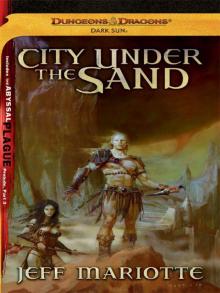 City Under the Sand
City Under the Sand The Burning Season
The Burning Season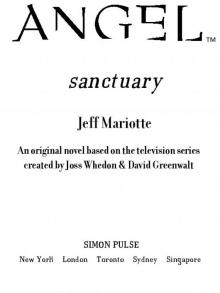 Sanctuary
Sanctuary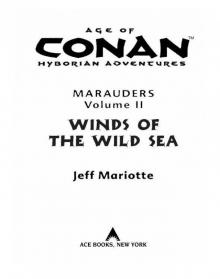 Winds of the Wild Sea
Winds of the Wild Sea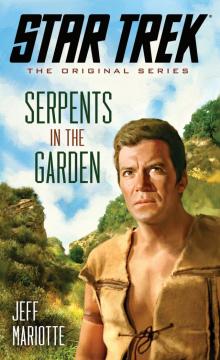 Serpents in the Garden
Serpents in the Garden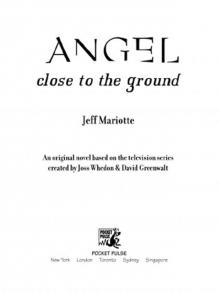 Close to the Ground
Close to the Ground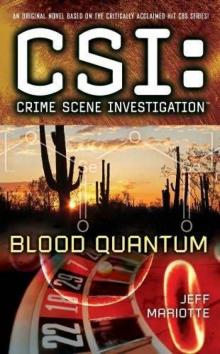 Blood Quantum
Blood Quantum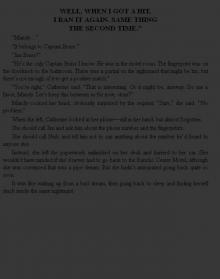 Brass in Pocket
Brass in Pocket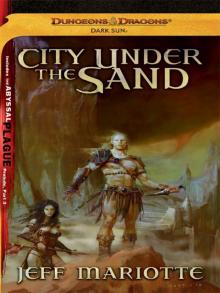 City Under the Sand: A Dark Sun Novel (Dungeons & Dragons: Dark Sun)
City Under the Sand: A Dark Sun Novel (Dungeons & Dragons: Dark Sun)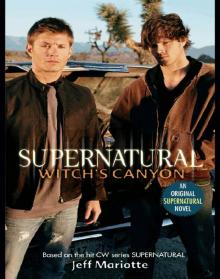 Witch's Canyon
Witch's Canyon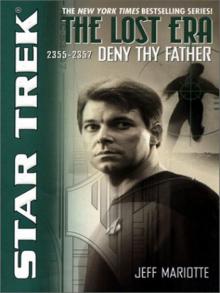 STAR TREK: The Lost Era - 2355-2357 - Deny Thy Father
STAR TREK: The Lost Era - 2355-2357 - Deny Thy Father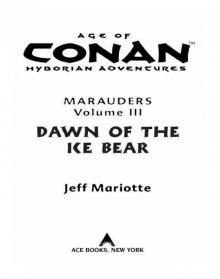 Dawn of the Ice Bear
Dawn of the Ice Bear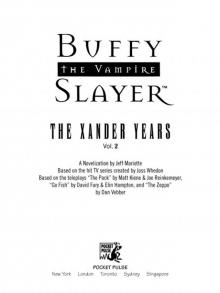 The Xander Years, Vol.2
The Xander Years, Vol.2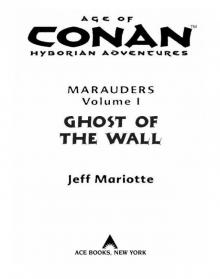 Ghost of the Wall
Ghost of the Wall 30 Days of Night: Light of Day
30 Days of Night: Light of Day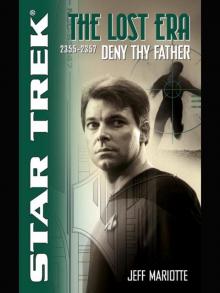 Deny Thy Father
Deny Thy Father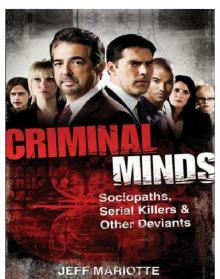 Criminal Minds
Criminal Minds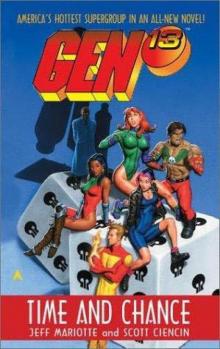 Time and Chance
Time and Chance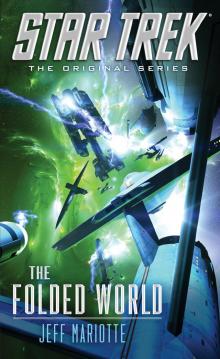 The Folded World
The Folded World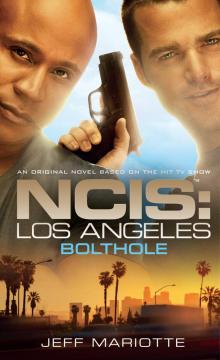 Bolthole
Bolthole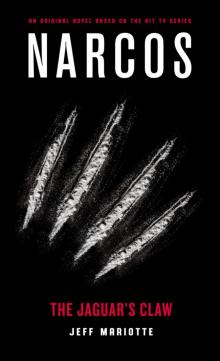 Narcos
Narcos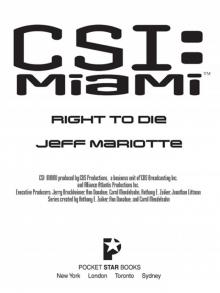 Right to Die
Right to Die